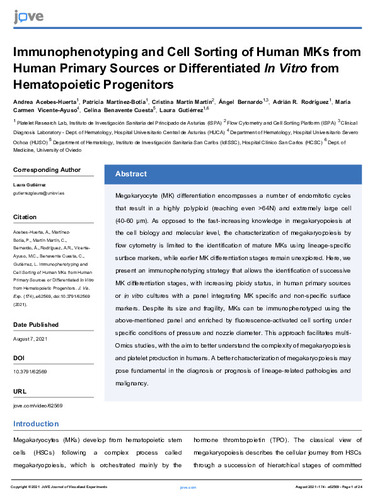Immunophenotyping and cell sorting of human MKs from human primary sources or differentiated in vitro from hematopoietic progenitors
Fecha de publicación:
Versión del editor:
Citación:
Resumen:
Megakaryocyte (MK) differentiation encompasses a number of endomitotic cycles that result in a highly polyploid (reaching even >64N) and extremely large cell (40-60 µm). As opposed to the fast-increasing knowledge in megakaryopoiesis at the cell biology and molecular level, the characterization of megakaryopoiesis by flow cytometry is limited to the identification of mature MKs using lineage-specific surface markers, while earlier MK differentiation stages remain unexplored. Here, we present an immunophenotyping strategy that allows the identification of successive MK differentiation stages, with increasing ploidy status, in human primary sources or in vitro cultures with a panel integrating MK specific and non-specific surface markers. Despite its size and fragility, MKs can be immunophenotyped using the above-mentioned panel and enriched by fluorescence-activated cell sorting under specific conditions of pressure and nozzle diameter. This approach facilitates multi-Omics studies, with the aim to better understand the complexity of megakaryopoiesis and platelet production in humans. A better characterization of megakaryopoiesis may pose fundamental in the diagnosis or prognosis of lineage-related pathologies and malignancy.
Megakaryocyte (MK) differentiation encompasses a number of endomitotic cycles that result in a highly polyploid (reaching even >64N) and extremely large cell (40-60 µm). As opposed to the fast-increasing knowledge in megakaryopoiesis at the cell biology and molecular level, the characterization of megakaryopoiesis by flow cytometry is limited to the identification of mature MKs using lineage-specific surface markers, while earlier MK differentiation stages remain unexplored. Here, we present an immunophenotyping strategy that allows the identification of successive MK differentiation stages, with increasing ploidy status, in human primary sources or in vitro cultures with a panel integrating MK specific and non-specific surface markers. Despite its size and fragility, MKs can be immunophenotyped using the above-mentioned panel and enriched by fluorescence-activated cell sorting under specific conditions of pressure and nozzle diameter. This approach facilitates multi-Omics studies, with the aim to better understand the complexity of megakaryopoiesis and platelet production in humans. A better characterization of megakaryopoiesis may pose fundamental in the diagnosis or prognosis of lineage-related pathologies and malignancy.
Descripción:
Methods Collections: In vitro and in vivo models for the study of Megakaryocytes
ISSN:
DOI:
Patrocinado por:
This work was partially supported by Medical Grants (Roche SP200221001) to A.B., an RYC fellowship (RYC-2013-12587; Ministerio de Economía y Competitividad, Spain) and an I+D 2017 grant (SAF2017-85489-P; Ministerio de Ciencia, Innovación y Universidades, Spain and Fondos FEDER) to L.G., a Severo Ochoa Grant (PA-20-PF-BP19-014; Consejería de Ciencia, Innovación y Universidades del Principado de Asturias, Spain) to P.M.-B. and an intramural postdoctoral grant 2018 (Fundación para la Investigación y la Innovación Biosanitaria de Asturias - FINBA, Oviedo, Spain) to A.A.-H. We thank Reinier van der Linden for sharing his knowledge (and time), especially his wise advice on multi-color tagged-antibody panel mix and single-color bead control preparation.
Colecciones
- Artículos [37541]
- Biología Funcional [807]
- Investigaciones y Documentos OpenAIRE [8416]
Ficheros en el ítem





